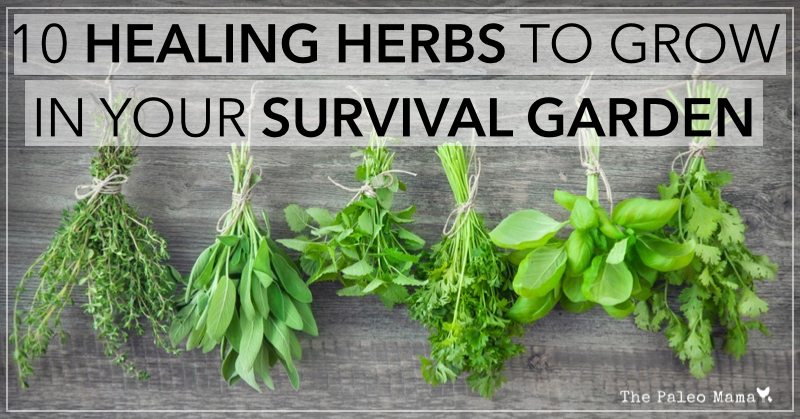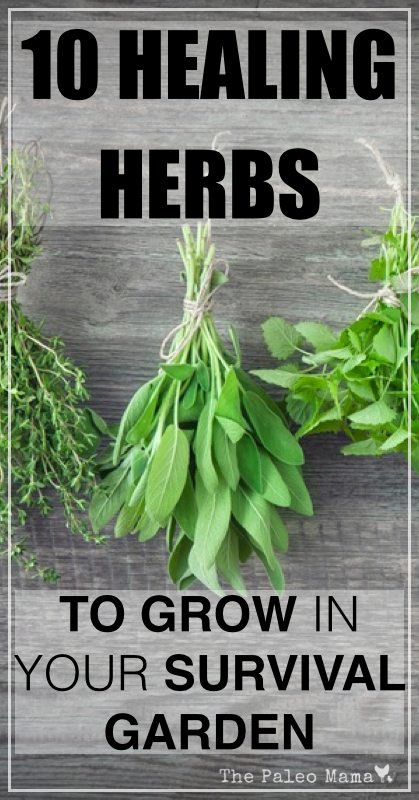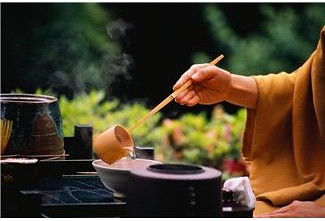
For many, the time has come to plan our summer gardens. My interest is a bit self-serving in that I am in the process of rethinking my own garden and while I grow an abundance of rosemary, lavender and peppermint, this year will be an ideal time to replace some tired shrubs with plants that will work for me. Healing herbs will fit the bill quote nicely.
Herbs have been used for centuries to sooth and to heal. According to Wikipedia:
Herbs have long been used as the basis of traditional Chinese herbal medicine, with usage dating as far back as the first century CE and before. Medicinal use of herbs in Western cultures has its roots in the Hippocratic (Greek) elemental healing system, based on a quaternary elemental healing metaphor.
With such a long history of use it makes perfect sense that you would want to include a selection of herbs in the survival garden.
Healing Herbs for the Healing Garden
Basil: People don’t usually think of basil as a healing herb and yet traditionally, it is called the “king of herbs”. It is used medicinally as a natural anti-inflammatory and is thought to have mild antiseptic functions. Some healing uses are for flatulence, lack off appetite, nausea and cuts and scrapes.
It is also superb on spaghetti and in pesto but then you already knew that. Basil is an annual plant so you will have to start anew each year.
German Chamomile: Chamomile is one of the most popular herbs in the Western world. Its flower heads are commonly used for infusions, teas and salves. These in turn can be used to treat indigestion, anxiety and skin inflammations. As a tea, it serves as a mild sedative to help with sleep.
Feverfew: This perennial is a member of the sunflower family and has been used for centuries in European folk medicine as a remedy for headaches, arthritis, and fevers. The name feverfew comes from a Latin word meaning “fever reducer.”
Its many uses include easing headache pains – especially migraines. This is done by chewing on the leaves. A tea made from the leaves and flowers is said to relieve the symptoms of arthritis.
Lemon Balm: Lemon balm is a member of the mint family. Considered a calming herb, it has been used as far back as the Middle Ages to reduce stress and anxiety, promote sleep, improve appetite, and ease pain and discomfort from indigestion. Even before the Middle Ages, lemon balm was steeped in wine to lift the spirits, help heal wounds, and treat venomous insect bites and stings.
As with many other herbs in your healing garden, lemon balm promotes relaxation and a sense of calm.
Parsley: While not one of my favorites, there is nothing like a sprig of parsley to take away bad breath. It is no wonder that this biennial (meaning it lives for two years) is used to decorate and garnish plates in the fanciest of restaurants.

When brewed as a tea, parsley can help supplement iron in a person’s diet, particularly for those who are anemic. Drinking parsley tea also boosts energy and overall circulation of the body, and helps battle fatigue from lack of iron. Other uses? Parsley tea fights gas and flatulence in the belly, kidney infections, and bladder infections. It can also be an effective diuretic.
Sage: Did you know that the genus name for sage is “salvia” which means “to heal”? In the first century C.E. Greek physician Dioscorides reported that sage stopped bleeding of wounds and cleaned ulcers and sores. He also recommended sage juice in warm water for hoarseness and cough. In modern times, a sage tea is used to sooth mouth, throat and gum inflammations. This is because sage has excellent antibacterial and astringent properties.
Thyme: Back during medieval times, thyme was given to knights before going in to battle. The purpose was to infuse this manly man with vigor and courage.
These days, thyme used to relieve coughs, congestion, indigestion and gas. This perennial is rich in thymol, a strong antiseptic, making thyme highly desirable in the treatment of wounds and even fungus infections. Thyme is a perennial that does well, even in cooler, Pacific Northwest climates.
Rosemary: Long ago, rosemary was known as ‘the herb of remembrance.’ Even today, in places like Australia and New Zealand, it is used as a symbol of remembrance since it is known to help sharpen mental clarity and stimulate brain function. You might recall that many statues of the ancient Greeks and Romans show men wearing sprigs of rosemary on their heads – signifying mental acuity.
The needles of the delightfully fragrant rosemary plant can be used in a tea to treat digestive problems. The same tea can also be used as an expectorant and as a relaxing beverage that is helpful for headaches. Other healing uses include improving memory, relieving muscle pain and spasms, stimulating hair growth, and supporting the circulatory and nervous systems.
Peppermint: Peppermint has a long tradition of medicinal use. Archaeological evidence places its use far back as ten thousand years ago. It is commonly used to soothe or treat symptoms such as nausea, vomiting, abdominal pain, indigestion, irritable bowel, and bloating and more.
The leaves and stems contain menthol which in addition to use medicinally, is used as a flavoring in food, and a fragrance in cosmetics. The plant is prolific, growing well in moist, shaded areas as well as in sunnier locations. The roots emit runners that can quickly overtake the garden so most gardeners prefer to plant peppermint in pots.
The easiest way to acquire a peppermint plant? Find a friend or neighbor that is growing peppermint to break off a stem. Place it is a glass of water and in a very short period of times, roots will form an you will have your own peppermint start.
Lavender: I saved my personal favorite for last. Of course it helps that I have an abundant amount of fragrant lavender in my yard.
A tea made from lavender has many uses with one of the foremost being it’s ability to have a calming effect on a person’s mind and body. To that end, lavender can promote a sense of well-being and alleviate stress. It is also useful for dealing with various gastrointestinal issues such as upset stomachs and flatulence.
Because it is a strong antiseptic, lavender tea, when applied topically, can help heal cuts, wounds and sores. It can also be used to mitigate bad breath.
How Do I Get Started?
With so many to herbs to choose from, where do you start? A lot will depend on the amount of space you have, the climate, and the availability of seeds, starts, or cuttings. My recommendation is that you start with three or four herbs that appeal to you from a healing perspective. Many can be grown in pots on a porch or deck so if space is a problem, you can start modestly.
How to Make an Herbal Tea
The process of making a pot of herbal tea is in itself healing. Perhaps that has something to do with the proactive effort involved in doing something positive for one’s own self and well-being. And luckily, brewing an herbal tea is easy.

To make an herbal tea, first bring some cool water to a boil. While waiting for the water to boil, fetch a non-mental container that will be used to brew the tea. A quart mason jar works nicely for this purpose. You do not want to use a metal container since the metal may interfere with the purity and taste of the tea.
Add 2 tablespoons of fresh (or 1 tablespoon of dried herb or crushed seed) to the empty pot or jar for each cup of water. Then, and this is the important part, add an extra 2 tablespoons of fresh (or 1 tablespoon of dried) herbs “for the pot.” So, for example, if you are making 2 cups of hot tea, you would use 6 tablespoons of fresh herbs or 3 tablespoons of dried herbs.
Pour the boiling water over the herbs and let them steep, covered, for about 5 minutes give or take. There is no exact time since everyone’s strength preference is difference. When ready, strain the herbs and pour the tea into a cup. At this point you may want to garnish your heavenly – and healing – cup of tea with honey, citrus fruits or addition herb sprigs.
For iced tea, increase the quantity of herbs in the basic recipe by 1 1/2 to allow for dilution from the melting ice.
The Final Word
In reading about these herbs, you may have noticed that many are reputed to have the same or similar healing qualities. Do they work? I can personally vouch for Rosemary and Lavender which I have used as both a tea and as an essential oil.
One thing that is true is that with a little time and for a nominal cost, you can grow the makings for healing teas, infusions and balms in your own garden. Add a dose of sun and some rich potting soil and you will be set to go. Just keep in mind that while perennial plants will flourish over the winter and will be there for you the following spring, annual plants must be reseeded or restarted every year.
If you would like to learn more about the healing properties of various herbs, the University of Maryland Medical Center has an excellent web site with a lot of useful information about herbs and other alternative medicine topics. Click on “herbs” then scroll down to the particular herb you would like to learn about.
Original Source: Natural Blaze
Hi, I’m new to “The Paleo Mama” email. I like what I see so far, I have two questions. I do not have a green thumb, but I so want to start doing a small garden. One for some vegetables that grow themselves with a little tender loving care from the “farmer”, and to be able to grow some herbs that can be used medicinally and for cooking. My first question is that I don’t know which plants grow themselves in Georgia, in our climate. Can you point me towards how to actually get my learning rolling? Tips, or your opinion on what you would grow. My second question is that, I have a German Shepard that has some skin problems, and was wondering if some of the essentials oils are safe to use on him, and if so, which ones should I try? Thank you for any and all help. Jesus is Lord
Go to growveg.com and do the free trial. It can help you plan a garden for your area. For your dog…check out thedogoiler.com!
Thanks for the article, Jackie. Tidying up: “of” for “off” in “Some healing uses are for flatulence, lack off appetite, nausea and cuts and scrapes.”
I wanted to mention that parsley shouldn’t be used during pregnancy as it is considered abortive. As a matter of fact, it might be a good idea to check contraindications of all herbs. A couple of years ago my period was very late (2 weeks). I made sure I was not pregnant. I drank 3 cups of parsley tea over the course of a day. I got intense cramps and finally my period. Just a story to illustrate the power of herbs. I will be including your suggestions in my garden, at least I hope to! Thanks for the post.
What about Gunja, is that a herb? if it is it should be at the top of the list :))
Another warning we found out the hard way: sage is a common seizure trigger for those with epilepsy.
Women used to put parsley in their vagina to abort. Apparently it has poisonous properties. It’s dangerous to do that however and it’s always better to go to a real clinic
Good post, and the other comments are helpful!
Peppermint should be avoided by breastfeeders as it can hinder milk production. 🙂
I have heard the similar things about not drinking parsley tea while pregnant.
I just wanted to add that stinging nettles are actually really good for you, they are fab for the immune system. Just don’t drink it at night it will keep you awake!
I grow several kinds of thyme, mints, lemon balm, sage, French tarragon and feverfew in my garden at 6000 feet in Wyoming. I buy several parsley plants and rosemary in the spring and harvest them during the summer and dry the rosemary for winter use. Basil has to be in the greenhouse here. I haven’t tried lavender–not a fan of most lavender and it is rather tender.
A quick side note about parsley tea – don’t drink it if you’re pregnant!
Any herb for medicinal should always be looked into thoroughly!!! Every body is different, so it’s the same with otc drugs or doc. prescriptions…you have your own set of things to watch out for! I loved this article! When I started my herb gardens I just planted and planted and now each year learn about two or three more in detail and have upped my usage. My first used and still favorite for my kids is the lemon balm though! I make hot tea and add honey for colds and flues- it’s like a hot-tottie for kids that won’t send you to prison (you don’t add the whiskey…) Something about just “doing” something is medicine itself!
I am very interested in growing my own teas for my own pleasure. And to tell others.Specially since I live in the Yukon, Canada. Thanking you in advance. Ron
I can’t imagine omitting Yarrow (Achillea millefolium) from a “survival garden”… it is quite possibly the most indispensable first aid herb that ever grew. And Calendula officinalis. And Aloe. And Elder (Sambucus nigra).
These are seriously effective herbs.
The title of your article is incredibly misleading. It should be something more like “Herbs for minor discomforts”. As another commenter pointed out already, you have not included many of the most healing and “survival” plants. There are many plants that will not only heal major problems but also that you can actually “survive” from eating. One of the things I learned over 30 years ago was about “survival” plants that you could grow that could keep you alive after a major disaster and that other people do not usually recognize as edible. One great example is Comfrey. You should learn to recognize which weeds are edible, since many are much more nutritious than food we grow, they can always be found, and most people don’t know they are edible.
How do you make tea out of parsley
You can find one recipe at: https://healthyeating.sfgate.com/make-parsley-tea-fresh-parsley-7478.html
I like the article and the fact that you included all common herbs, like in the Simon and Garfunkel song, ‘Scarborough Fair’-“parsley, sage, rosemary and thyme” (all perennials). But my question is, how do you extract oils from herbs?